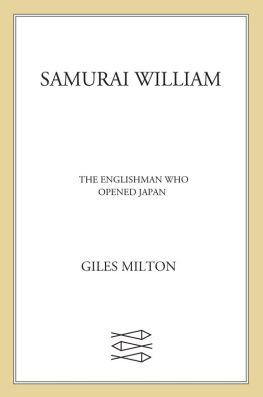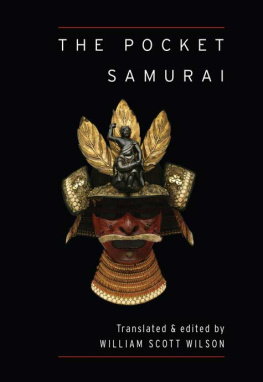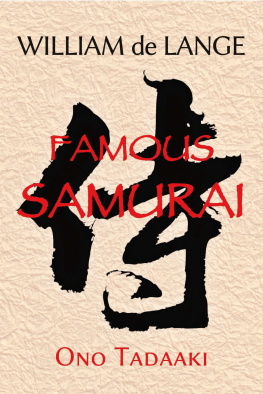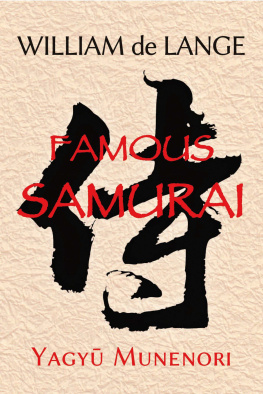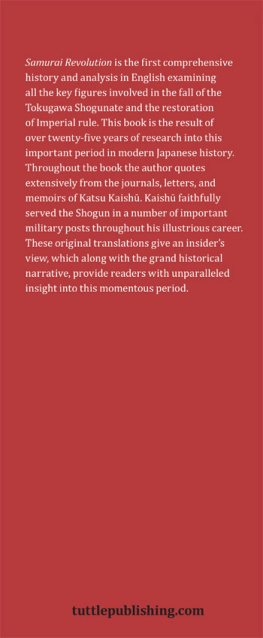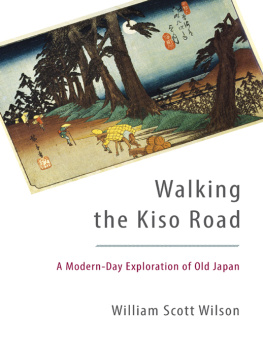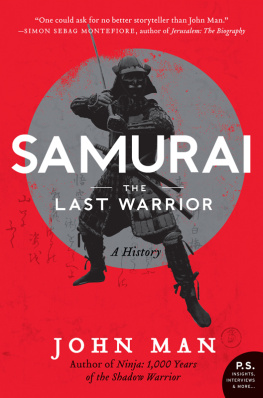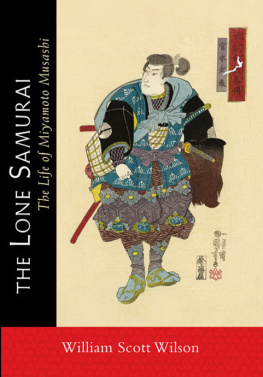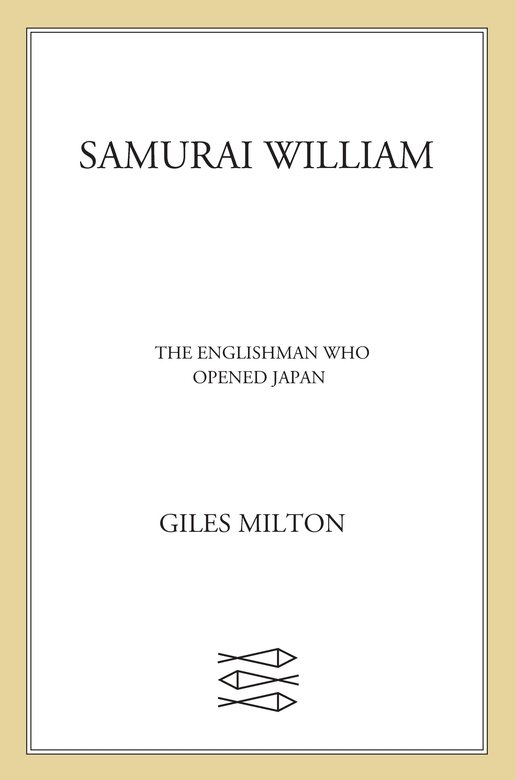The story of Samurai William has been drawn from Jacobean letters and journals. I am extremely grateful to the scholars who have collected and published these colorful records. The relevant sources are cited in the Notes and Sources, but one work must be singled out for special mention. Anthony Farringtons magnificent The English Factory in Japan , a monumental collection of original material, has proved invaluable in compiling a portrait of the English in Japan.
I have received much help from researchers and translators. A thank you to Laura Inoue in Tokyo for her advice, hard work, and hot plum brandy. My thanks, as well, to the staff of the Japan Foundation Library in Tokyo. I am also most grateful to Takako Suga, my guide/translator in Hirado.
Thank you to Marjolein van der Valk for translating scores of pages of De Ries van Mahu en de Cordes . And special thanks to Peter ten Arve in Rotterdam for locating and translating original Dutch manuscripts.
In London, my thanks to Maggie Noach and Jill Hughes; to Roland Philipps, Lizzie Dipple, and Celia Levett. Thank you also to George Tiffin, for photographing many of the illustrations; to Frank Barrett and Wendy Driver; and to the ever-helpful staff (and friends) at the London Library, where much of this book was written.
I am particularly grateful to Paul Whyles for reading and rereading the manuscript at short notice and suggesting much-needed changes.
Lastly, I wish to say a huge thank you to Alexandra for her encouragement, support, and friendly advice; and to Madeleine and Hlose for their banter and jokes.
William Adams and his men left a wealth of material about their new lives in Japan. But their handwritten letters and journalsmostly housed in the British Libraryare extremely hard to decipher. Until very recently, only a few of these had been published, often in editions that were far from satisfactory. Richard Cockss colorful diary, for example, first printed in 1883 for the Hakluyt Society, was heavily expurgated by its Victorian editor.
In researching and writing Samurai William, I have been fortunate to have access to new and scholarly printed editions. Anthony Farringtons two-volume The English Factory in Japan, 161323 , published in 1991 by the British Library, is indispensable. It contains all Adamss letters and logbooks, along with those of his colleagues, and it also includes the factorys account books, wills, and diaries. It supplants Thomas Rundalls Memorials of the Empire of Japan in the XVI and XVII Centuries , published by the Hakluyt Society in 1850.
The three-volume edition of Richard Cockss diary, published 197881, is also invaluable (see notes for Chapter 8); it contains all the material missing from the volumes published in 1883.
Derek Massarellas superb A World Elsewhere: Europes Encounter with Japan in the Sixteenth and Seventeenth Centuries , published in 1990 by Yale University Press, provides a detailed analysis of both the English and the Dutch in Japan, and considers the reasons for the economic decline of the Hirado factory
The history of the Catholic missions in Japan remains underresearched. C. R. Boxers Christian Century in Japan was published by Cambridge University Press in 1951, yet it remains the standard text on the missions. It is best read in conjunction with Michael Coopers They Came to Japan: An Anthology of European Reports on Japan, 15431640 , published by Thames & Hudson in 1965. This contains generous extracts from Padre Alessandro Valignanos Historia del Principio y Progresso de la Compania de Jesus en las Indias Orientales; Padre Luis Froiss Historia do Japo and Cartas; and Padre Joo Rodriguess Historia da Igreja do Japo.
Michael Coopers book Joo Rodriguess Account of Sixteenth-Century Japan , published in 2002 by the Hakluyt Society, is a welcome addition to his This Island of Japan: Joo Rodrigues Account of 16th-Century Japan, published in Tokyo and New York by Kodansha International, 1973.
An excellent background to the period is provided by Donald Lach in his monumental Asia in the Making of Europe , published in nine volumes by the University of Chicago Press, 196593. Much of the relevant information about Japan can be found in Volume 3, Book 4, Chapter 23. Another invaluable reference book is the Kodansha Encyclopaedia of Japan , published by Kodansha in Tokyo.
Many of the books listed below are long out of print, and someespecially those published in the aftermath of World War IIare not available in the UK. The most comprehensive collection of material relating to the English in Japan is housed in the Japan Foundation in Tokyo.
A full reference for each book will be given when it is first mentioned in these notes.
Prologue
The saltiest and most piquant Elizabethan worldview is to be found in Richard Hakluyts twelve-volume The Principal Navigations , Voyages, Traffiques and Discoveries of the English Nation. Hakluyt collected his material firsthandfrom newly returned captains and marinersand his book contains a wealth of material on the Indies, Africa, and the Americas. Japanyet to be visited by an Englishmanreceives only cursory coverage. First published in its enlarged edition between 1598 and 1600, it was reprinted as a Hakluyt Society Extra Series in 19035.
William Adams belonged to a generation whose horizons were continually expanding. The newly awakened sense of global possibility is expressed most eloquently and enthusiastically by the Arctic adventurer George Beste. His preface to the account of Martin Frobishers 1576 expedition can be found in the Hakluyt Societys The Three Voyages of Martin Frobisher , 1867.
Chapter 1
An outline of the voyages and accounts of the first Europeans in Japanincluding an investigation into their veracitycan be found in Chapter I of C. R. Boxers Christian Century in Japan. Michael Coopers illustrated Southern Barbarians: The First Europeans in Japan, published by Kodansha International in 1971, focuses on the Jesuits in Japan and includes generous extracts from Frois and Rodrigues. Additional material on early Portuguese adventurers can be found in the fourth volume of Georg Schurhammers monumental Francis Xavier, His Life, His Times , published by the Jesuit Historical Institute in Rome in 1982; see especially p. 260 ff, note 95118.
The first English translation of Ferao Mendes Pintos Peregrinaam, entitled The Voyages and Adventures, was published in 1663.
The Otomo family fortunes are dealt with in some detail in The Cambridge History of Japan, published by Cambridge University Press in 1993; see Volume 4, edited by John Whitney Hall, pp. 3505.
The brief outline of Japanese history during the sengoku jidai (the era of civil wars) is drawn largely from James Murdoch and Isoh Yamagatas A History of Japan during the Century of Early Foreign Intercourse, 15121651 , first published by the Asiatic Society of Japan in Kobe in 1903.
Jorge Alvarezs report on the Japanese can be found, in an English translation, in the first chapter of C. R. Boxers Christian Century in Japan. Francis Xaviers mission to Japan is covered in exhaustive detail in Georg Schurhammers biography. The footnotes in Volume 4 contain lengthy quotations from original sources.

